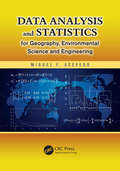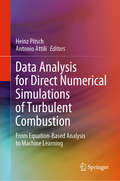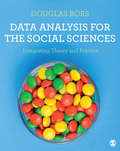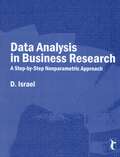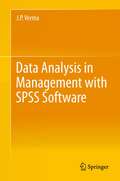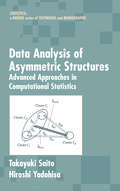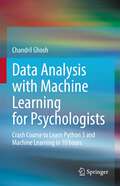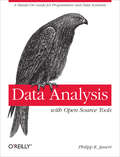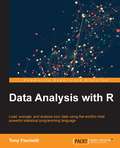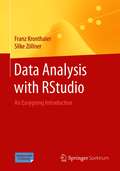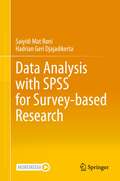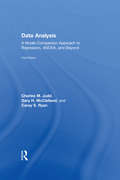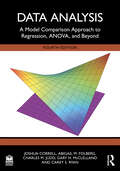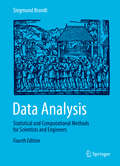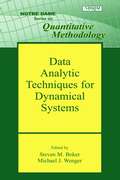- Table View
- List View
Data Analysis and Statistics for Geography, Environmental Science, and Engineering
by Miguel F. AcevedoProviding a solid foundation for twenty-first-century scientists and engineers, Data Analysis and Statistics for Geography, Environmental Science, and Engineering guides readers in learning quantitative methodology, including how to implement data analysis methods using open-source software. Given the importance of interdisciplinary work in sustain
Data Analysis for Direct Numerical Simulations of Turbulent Combustion: From Equation-Based Analysis to Machine Learning
by Heinz Pitsch Antonio AttiliThis book presents methodologies for analysing large data sets produced by the direct numerical simulation (DNS) of turbulence and combustion. It describes the development of models that can be used to analyse large eddy simulations, and highlights both the most common techniques and newly emerging ones. The chapters, written by internationally respected experts, invite readers to consider DNS of turbulence and combustion from a formal, data-driven standpoint, rather than one led by experience and intuition. This perspective allows readers to recognise the shortcomings of existing models, with the ultimate goal of quantifying and reducing model-based uncertainty. In addition, recent advances in machine learning and statistical inferences offer new insights on the interpretation of DNS data. The book will especially benefit graduate-level students and researchers in mechanical and aerospace engineering, e.g. those with an interest in general fluid mechanics, applied mathematics, and the environmental and atmospheric sciences.
Data Analysis for Scientists and Engineers
by Stuart L. MeyerWiley series in probability and mathematical statistics
Data Analysis for Social Science: A Friendly and Practical Introduction
by Kosuke Imai Elena LlaudetAn ideal textbook for an introductory course on quantitative methods for social scientists—assumes no prior knowledge of statistics or coding <p><p>Data Analysis for Social Science provides a friendly introduction to the statistical concepts and programming skills needed to conduct and evaluate social scientific studies. Using plain language and assuming no prior knowledge of statistics and coding, the book provides a step-by-step guide to analyzing real-world data with the statistical program R for the purpose of answering a wide range of substantive social science questions. It teaches not only how to perform the analyses but also how to interpret results and identify strengths and limitations. This one-of-a-kind textbook includes supplemental materials to accommodate students with minimal knowledge of math and clearly identifies sections with more advanced material so that readers can skip them if they so choose. <p><p>Analyzes real-world data using the powerful, open-sourced statistical program R, which is free for everyone to use <p><p>Teaches how to measure, predict, and explain quantities of interest based on data <p><p>Shows how to infer population characteristics using survey research, predict outcomes using linear models, and estimate causal effects with and without randomized experiments <p><p>Assumes no prior knowledge of statistics or coding <p><p>Specifically designed to accommodate students with a variety of math backgrounds <p><p>Provides cheatsheets of statistical concepts and R code <p><p>Supporting materials available online, including real-world datasets and the code to analyze them, plus—for instructor use—sample syllabi, sample lecture slides, additional datasets, and additional exercises with solutions <p><p>Looking for a more advanced introduction? Consider Quantitative Social Science by Kosuke Imai. In addition to covering the material in Data Analysis for Social Science, it teaches diffs-in-diffs models, heterogeneous effects, text analysis, and regression discontinuity designs, among other things.
Data Analysis for Social Science: A Friendly and Practical Introduction
by Kosuke Imai Elena LlaudetAn ideal textbook for complete beginners—teaches from scratch R, statistics, and the fundamentals of quantitative social scienceData Analysis for Social Science provides a friendly introduction to the statistical concepts and programming skills needed to conduct and evaluate social scientific studies. Assuming no prior knowledge of statistics and coding and only minimal knowledge of math, the book teaches the fundamentals of survey research, predictive models, and causal inference while analyzing data from published studies with the statistical program R. It teaches not only how to perform the data analyses but also how to interpret the results and identify the analyses&’ strengths and limitations.Progresses by teaching how to solve one kind of problem after another, bringing in methods as needed. It teaches, in this order, how to (1) estimate causal effects with randomized experiments, (2) visualize and summarize data, (3) infer population characteristics, (4) predict outcomes, (5) estimate causal effects with observational data, and (6) generalize from sample to population.Flips the script of traditional statistics textbooks. It starts by estimating causal effects with randomized experiments and postpones any discussion of probability and statistical inference until the final chapters. This unconventional order engages students by demonstrating from the very beginning how data analysis can be used to answer interesting questions, while reserving more abstract, complex concepts for later chapters.Provides a step-by-step guide to analyzing real-world data using the powerful, open-source statistical program R, which is free for everyone to use. The datasets are provided on the book&’s website so that readers can learn how to analyze data by following along with the exercises in the book on their own computer.Assumes no prior knowledge of statistics or coding.Specifically designed to accommodate students with a variety of math backgrounds. It includes supplemental materials for students with minimal knowledge of math and clearly identifies sections with more advanced material so that readers can skip them if they so choose.Provides cheatsheets of statistical concepts and R code.Comes with instructor materials (upon request), including sample syllabi, lecture slides, and additional replication-style exercises with solutions and with the real-world datasets analyzed. Looking for a more advanced introduction? Consider Quantitative Social Science by Kosuke Imai. In addition to covering the material in Data Analysis for Social Science, it teaches diffs-in-diffs models, heterogeneous effects, text analysis, and regression discontinuity designs, among other things.
Data Analysis for the Life Sciences with R
by Rafael A. Irizarry Michael I. LoveThis book covers several of the statistical concepts and data analytic skills needed to succeed in data-driven life science research. The authors proceed from relatively basic concepts related to computed p-values to advanced topics related to analyzing highthroughput data. They include the R code that performs this analysis and connect the lines of code to the statistical and mathematical concepts explained.
Data Analysis for the Social Sciences: Integrating Theory and Practice
by Professor Douglas Bors'This book fosters in-depth understanding of the logic underpinning the most common statistical tests within the behavioural sciences. By emphasising the shared ground between these tests, the author provides crucial scaffolding for students as they embark upon their research journey.' —Ruth Horry, Psychology, Swansea University 'This unique text presents the conceptual underpinnings of statistics as well as the computation and application of statistics to real-life situations--a combination rarely covered in one book. A must-have for students learning statistical techniques and a go-to handbook for experienced researchers.' —Barbra Teater, Social Work, College of Staten Island, City University of New York Accessible, engaging, and informative, this book will help any social science student approach statistics with confidence. With a well-paced and well-judged integrated approach rather than a simple linear trajectory, this book progresses at a realistic speed that matches the pace at which statistics novices actually learn. Packed with global, interdisciplinary examples that ground statistical theory and concepts in real-world situations, it shows students not only how to apply newfound knowledge using IBM SPSS Statistics, but also why they would want to. Spanning statistics basics like variables, constants, and sampling through to t-tests, multiple regression and factor analysis, it builds statistical literacy while also covering key research principles like research questions, error types and results reliability. It shows you how to: Describe data with graphs, tables, and numbers Calculate probability and value distributions Test a priori and post hoc hypotheses Conduct Chi-squared tests and observational studies Structure ANOVA, ANCOVA, and factorial designs Supported by lots of visuals and a website with interactive demonstrations, author video, and practice datasets, this book is the student-focused companion to support students through their statistics journeys.
Data Analysis for the Social Sciences: Integrating Theory and Practice
by Professor Douglas Bors'This book fosters in-depth understanding of the logic underpinning the most common statistical tests within the behavioural sciences. By emphasising the shared ground between these tests, the author provides crucial scaffolding for students as they embark upon their research journey.' —Ruth Horry, Psychology, Swansea University 'This unique text presents the conceptual underpinnings of statistics as well as the computation and application of statistics to real-life situations--a combination rarely covered in one book. A must-have for students learning statistical techniques and a go-to handbook for experienced researchers.' —Barbra Teater, Social Work, College of Staten Island, City University of New York Accessible, engaging, and informative, this book will help any social science student approach statistics with confidence. With a well-paced and well-judged integrated approach rather than a simple linear trajectory, this book progresses at a realistic speed that matches the pace at which statistics novices actually learn. Packed with global, interdisciplinary examples that ground statistical theory and concepts in real-world situations, it shows students not only how to apply newfound knowledge using IBM SPSS Statistics, but also why they would want to. Spanning statistics basics like variables, constants, and sampling through to t-tests, multiple regression and factor analysis, it builds statistical literacy while also covering key research principles like research questions, error types and results reliability. It shows you how to: Describe data with graphs, tables, and numbers Calculate probability and value distributions Test a priori and post hoc hypotheses Conduct Chi-squared tests and observational studies Structure ANOVA, ANCOVA, and factorial designs Supported by lots of visuals and a website with interactive demonstrations, author video, and practice datasets, this book is the student-focused companion to support students through their statistics journeys.
Data Analysis in Business Research: A Step-By-Step Nonparametric Approach (Response Books)
by D IsraelWhile there are books focusing on parametric tests, the domain of nonparametric tests is mostly unexplored. Data Analysis in Business Research: A Step by Step Nonparametric Approach brings under one umbrella all the major nonparametric statistical tools that can be used by undergraduate and postgraduate students of all disciplines, especially students of Research Methods in Social Sciences and Management Studies, in their dissertation work. Students face difficulty in analyzing data collected from small samples; they end up reporting mere percentage analysis which results in the loss of information collected. Hence there is a need to create awareness among students and researchers about the application of major nonparametric tools that can be applied confidently without worrying about sample size, scale of measurement, normality assumptions or other parameters of that nature. The lucid presentation of the step-by-step procedures, explaining in simple English how to perform each of the major nonparametric tests, is a major attraction of the book. The book, which also has a comprehensive question bank, assumes minimal or little knowledge of statistics on the part of the reader. This book will also be informative for Marketing Research professionals and organisations, consultancies and organisations of economic research.
Data Analysis in Management with SPSS Software
by J. P. VermaThis book provides readers with a greater understanding of a variety of statistical techniques along with the procedure to use the most popular statistical software package SPSS. It strengthens the intuitive understanding of the material, thereby increasing the ability to successfully analyze data in the future. The book provides more control in the analysis of data so that readers can apply the techniques to a broader spectrum of research problems. This book focuses on providing readers with the knowledge and skills needed to carry out research in management, humanities, social and behavioural sciences by using SPSS.
Data Analysis of Asymmetric Structures: Advanced Approaches in Computational Statistics
by Takayuki Saito Hiroshi YadohisaData Analysis of Asymmetric Structures provides a comprehensive presentation of a variety of models and theories for the analysis of asymmetry and its applications and provides a wealth of new approaches in every section. It meets both the practical and theoretical needs of research professionals across a wide range of disciplines and
Data Analysis of Medical Studies: Reading and Reporting
by Potter C. ChangThis book is written for the many health professionals who are regularly frustrated by elegant but ambiguous descriptions of results of data analysis. It uses articles of the New England Journal of Medicine to demonstrate how ambiguous descriptions of results of data analysis may be read, so that it is clear what they do and do not reveal. These demonstrations also show how statistics is misused.
Data Analysis with Competing Risks and Intermediate States (Chapman & Hall/CRC Biostatistics Series)
by Ronald B. GeskusThis practical and thorough book explains when and how to use models and techniques for the analysis of competing risks and intermediate states. It covers the most recent insights on estimation techniques and discusses in detail how to interpret the obtained results. Each chapter includes standard exercises; a software section on SAS, Stata, and R; and computer practicals that allow readers to practice with the techniques. The book's website provides the R code for the computer practicals along with other material.
Data Analysis with Machine Learning for Psychologists: Crash Course to Learn Python 3 and Machine Learning in 10 hours
by Chandril GhoshThe power of data drives the digital economy of the 21st century. It has been argued that data is as vital a resource as oil was during the industrial revolution. An upward trend in the number of research publications using machine learning in some of the top journals in combination with an increasing number of academic recruiters within psychology asking for Python knowledge from applicants indicates a growing demand for these skills in the market. While there are plenty of books covering data science, rarely, if ever, books in the market address the need of social science students with no computer science background. They are typically written by engineers or computer scientists for people of their discipline. As a result, often such books are filled with technical jargon and examples irrelevant to psychological studies or projects. In contrast, this book was written by a psychologist in a simple, easy-to-understand way that is brief and accessible. The aim for this book was to make the learning experience on this topic as smooth as possible for psychology students/researchers with no background in programming or data science. Completing this book will also open up an enormous amount of possibilities for quantitative researchers in psychological science, as it will enable them to explore newer types of research questions.
Data Analysis with Open Source Tools: A Hands-On Guide for Programmers and Data Scientists
by Philipp K. JanertCollecting data is relatively easy, but turning raw information into something useful requires that you know how to extract precisely what you need. With this insightful book, intermediate to experienced programmers interested in data analysis will learn techniques for working with data in a business environment. You'll learn how to look at data to discover what it contains, how to capture those ideas in conceptual models, and then feed your understanding back into the organization through business plans, metrics dashboards, and other applications.Along the way, you'll experiment with concepts through hands-on workshops at the end of each chapter. Above all, you'll learn how to think about the results you want to achieve -- rather than rely on tools to think for you.Use graphics to describe data with one, two, or dozens of variablesDevelop conceptual models using back-of-the-envelope calculations, as well asscaling and probability argumentsMine data with computationally intensive methods such as simulation and clusteringMake your conclusions understandable through reports, dashboards, and other metrics programsUnderstand financial calculations, including the time-value of moneyUse dimensionality reduction techniques or predictive analytics to conquer challenging data analysis situationsBecome familiar with different open source programming environments for data analysis"Finally, a concise reference for understanding how to conquer piles of data."--Austin King, Senior Web Developer, Mozilla"An indispensable text for aspiring data scientists."--Michael E. Driscoll, CEO/Founder, Dataspora
Data Analysis with R
by Tony FischettiLoad, wrangle, and analyze your data using the world's most powerful statistical programming language About This Book * Load, manipulate and analyze data from different sources * Gain a deeper understanding of fundamentals of applied statistics * A practical guide to performing data analysis in practice Who This Book Is For Whether you are learning data analysis for the first time, or you want to deepen the understanding you already have, this book will prove to an invaluable resource. If you are looking for a book to bring you all the way through the fundamentals to the application of advanced and effective analytics methodologies, and have some prior programming experience and a mathematical background, then this is for you. What You Will Learn * Navigate the R environment * Describe and visualize the behavior of data and relationships between data * Gain a thorough understanding of statistical reasoning and sampling * Employ hypothesis tests to draw inferences from your data * Learn Bayesian methods for estimating parameters * Perform regression to predict continuous variables * Apply powerful classification methods to predict categorical data * Handle missing data gracefully using multiple imputation * Identify and manage problematic data points * Employ parallelization and Rcpp to scale your analyses to larger data * Put best practices into effect to make your job easier and facilitate reproducibility In Detail Frequently the tool of choice for academics, R has spread deep into the private sector and can be found in the production pipelines at some of the most advanced and successful enterprises. The power and domain-specificity of R allows the user to express complex analytics easily, quickly, and succinctly. With over 7,000 user contributed packages, it's easy to find support for the latest and greatest algorithms and techniques. Starting with the basics of R and statistical reasoning, Data Analysis with R dives into advanced predictive analytics, showing how to apply those techniques to real-world data though with real-world examples. Packed with engaging problems and exercises, this book begins with a review of R and its syntax. From there, get to grips with the fundamentals of applied statistics and build on this knowledge to perform sophisticated and powerful analytics. Solve the difficulties relating to performing data analysis in practice and find solutions to working with "messy data", large data, communicating results, and facilitating reproducibility. This book is engineered to be an invaluable resource through many stages of anyone's career as a data analyst. Style and approach Learn data analysis using engaging examples and fun exercises, and with a gentle and friendly but comprehensive "learn-by-doing" approach.
Data Analysis with R, Second Edition: A Comprehensive Guide To Manipulating, Analyzing, And Visualizing Data In R, 2nd Edition
by Tony FischettiR has spread deep into the private sector and can be found in the production pipelines at some of the most advanced and successful enterprises. Starting with the basics of R and statistical reasoning, this book dives into advanced predictive analytics, showing how to apply those techniques to real-world data though with real-world examples.
Data Analysis with RStudio: An Easygoing Introduction
by Franz Kronthaler Silke ZöllnerThe objective of this text is to introduce RStudio to practitioners and students and enable them to use R in their everyday work. It is not a statistical textbook, the purpose is to transmit the joy of analyzing data with RStudio. Practitioners and students learn how RStudio can be installed and used, they learn to import data, write scripts and save working results. Furthermore, they learn to employ descriptive statistics and create graphics with RStudio. Additionally, it is shown how RStudio can be used to test hypotheses, run an analysis of variance and regressions. To deepen the learned content, tasks are included with the solutions provided at the end of the textbook. This textbook has been recommended and developed for university courses in Germany, Austria and Switzerland.
Data Analysis with SPSS for Survey-based Research
by Hadrian Geri Djajadikerta Saiyidi Mat RoniThis book is written for research students and early-career researchers to quickly and easily learn how to analyse data using SPSS. It follows commonly used logical steps in data analysis design for research. The book features SPSS screenshots to assist rapid acquisition of the techniques required to process their research data. Rather than using a conventional writing style to discuss fundamentals of statistics, this book focuses directly on the technical aspects of using SPSS to analyse data. This approach allows researchers and research students to spend more time on interpretations and discussions of SPSS outputs, rather than on the mundane task of actually processing their data.
Data Analysis: A Model Comparison Approach To Regression, ANOVA, and Beyond, Third Edition
by Charles M. Judd Carey S. Ryan Gary H. McClellandData Analysis: A Model Comparison Approach to Regression, ANOVA, and Beyond is an integrated treatment of data analysis for the social and behavioral sciences. It covers all of the statistical models normally used in such analyses, such as multiple regression and analysis of variance, but it does so in an integrated manner that relies on the comparison of models of data estimated under the rubric of the general linear model. Data Analysis also describes how the model comparison approach and uniform framework can be applied to models that include product predictors (i.e., interactions and nonlinear effects) and to observations that are nonindependent. Indeed, the analysis of nonindependent observations is treated in some detail, including models of nonindependent data with continuously varying predictors as well as standard repeated measures analysis of variance. This approach also provides an integrated introduction to multilevel or hierarchical linear models and logistic regression. Finally, Data Analysis provides guidance for the treatment of outliers and other problematic aspects of data analysis. It is intended for advanced undergraduate and graduate level courses in data analysis and offers an integrated approach that is very accessible and easy to teach. Highlights of the third edition include: a new chapter on logistic regression; expanded treatment of mixed models for data with multiple random factors; updated examples; an enhanced website with PowerPoint presentations and other tools that demonstrate the concepts in the book; exercises for each chapter that highlight research findings from the literature; data sets, R code, and SAS output for all analyses; additional examples and problem sets; and test questions.
Data Analysis: A Model Comparison Approach to Regression, ANOVA, and Beyond
by Charles M. Judd Carey S. Ryan Gary H. McClelland Josh Correll Abigail M. FolbergThis essential textbook provides an integrated treatment of data analysis for the social and behavioral sciences. It covers all the key statistical models in an integrated manner that relies on the comparison of models of data estimated under the rubric of the general linear model.The text describes the foundational logic of the unified model comparison framework. It then shows how this framework can be applied to increasingly complex models including multiple continuous and categorical predictors, as well as product predictors (i.e., interactions and nonlinear effects). The text also describes analyses of data that violate assumptions of independence, homogeneity, and normality. The analysis of nonindependent data is treated in some detail, covering standard repeated measures analysis of variance and providing an integrated introduction to multilevel or hierarchical linear models and logistic regression.Highlights of the fourth edition include: Expanded coverage of generalized linear models and logistic regression in particular A discussion of power and ethical statistical practice as it relates to the replication crisis An expanded collection of online resources such as PowerPoint slides and test bank for instructors, additional exercises and problem sets with answers, new data sets, practice questions, and R code Clear and accessible, this text is intended for advanced undergraduate and graduate level courses in data analysis.
Data Analysis: A Model Comparison Approach, Second Edition
by Charles M. Judd Carey S. Ryan Gary H. McclellandThis completely rewritten classic text features many new examples, insights and topics including mediational, categorical, and multilevel models. Substantially reorganized, this edition provides a briefer, more streamlined examination of data analysis. Noted for its model-comparison approach and unified framework based on the general linear model, the book provides readers with a greater understanding of a variety of statistical procedures. This consistent framework, including consistent vocabulary and notation, is used throughout to develop fewer but more powerful model building techniques. The authors show how all analysis of variance and multiple regression can be accomplished within this framework. The model-comparison approach provides several benefits: It strengthens the intuitive understanding of the material thereby increasing the ability to successfully analyze data in the future It provides more control in the analysis of data so that readers can apply the techniques to a broader spectrum of questions It reduces the number of statistical techniques that must be memorized It teaches readers how to become data analysts instead of statisticians. The book opens with an overview of data analysis. All the necessary concepts for statistical inference used throughout the book are introduced in Chapters 2 through 4. The remainder of the book builds on these models. Chapters 5 - 7 focus on regression analysis, followed by analysis of variance (ANOVA), mediational analyses, non-independent or correlated errors, including multilevel modeling, and outliers and error violations. The book is appreciated by all for its detailed treatment of ANOVA, multiple regression, nonindependent observations, interactive and nonlinear models of data, and its guidance for treating outliers and other problematic aspects of data analysis. Intended for advanced undergraduate or graduate courses on data analysis, statistics, and/or quantitative methods taught in psychology, education, or other behavioral and social science departments, this book also appeals to researchers who analyze data. A protected website featuring additional examples and problems with data sets, lecture notes, PowerPoint presentations, and class-tested exam questions is available to adopters. This material uses SAS but can easily be adapted to other programs. A working knowledge of basic algebra and any multiple regression program is assumed.
Data Analysis: Statistical and Computational Methods for Scientists and Engineers
by Siegmund BrandtThe fourth edition of this successful textbook presents a comprehensive introduction to statistical and numerical methods for the evaluation of empirical and experimental data. Equal weight is given to statistical theory and practical problems. The concise mathematical treatment of the subject matter is illustrated by many examples and for the present edition a library of Java programs has been developed. It comprises methods of numerical data analysis and graphical representation as well as many example programs and solutions to programming problems. The programs (source code, Java classes and documentation) and extensive appendices to the main text are available for free download from the book's page at www. springer. com. Contents Probabilities. Random variables. Random numbers and the Monte Carlo Method. Statistical distributions (binomial, Gauss, Poisson). Samples. Statistical tests. Maximum Likelihood. Least Squares. Regression. Minimization. Analysis of Variance. Time series analysis. Audience The book is conceived both as an introduction and as a work of reference. In particular it addresses itself to students, scientists and practitioners in science and engineering as a help in the analysis of their data in laboratory courses, in working for bachelor or master degrees, in thesis work, in research and professional work. "The book is concise, but gives a sufficiently rigorous mathematical treatment of practical statistical methods for data analysis; it can be of great use to all who are involved with data analysis. " Physicalia ". . . Serves as a nice reference guide for any scientist interested in the fundamentals of data analysis on the computer. " The American Statistician "This lively and erudite treatise covers the theory of the main statistical tools and their practical applications. . . a first rate university textbook, and good background material for the practicing physicist. " Physics Bulletin The Author Siegmund Brandt is Emeritus Professor of Physics at the University of Siegen. With his group he worked on experiments in elementary-particle physics at the research centers DESY in Hamburg and CERN in Geneva in which the analysis of the experimental data plays an important role. He is author or coauthor of textbooks which have appeared in ten languages.
Data Analytic Techniques for Dynamical Systems (Notre Dame Series On Quantitative Methodology Ser.)
by Steven M. Boker Michael J. WengerEach volume in the Notre Dame Series on Quantitative Methodology features leading methodologists and substantive experts who provide instruction on innovative techniques designed to enhance quantitative skills in a substantive area. This latest volume focuses on the methodological issues and analyses pertinent to understanding psychological data from a dynamical system perspective. Dynamical systems analysis (DSA) is increasingly used to demonstrate time-dependent variable change. It is used more and more to analyze a variety of psychological phenomena such as relationships, development and aging, emotional regulation, and perceptual processes. The book opens with the best occasions for using DSA methods. The final two chapters focus on the application of dynamical systems methods to problems in psychology such as substance use and gestural dynamics. In addition, it reviews how and when to use: time series models from a discrete time perspective stochastic differential equations in continuous time estimating continuous time differential equation models multilevel models of differential equations to estimate within-person dynamics and the corresponding population means new SEM models for dynamical systems data Data Analytic Techniques for Dynamical Systems is beneficial to advanced students and researchers in the areas of developmental psychology, family studies, language processes, cognitive neuroscience, social and personality psychology, medicine, and emotion. Due to the book’s instructive nature, it serves as an excellent text for advanced courses on this particular technique.
Data Analytics Applications in Emerging Markets
by Jose Antonio Nuñez Mora M. Beatriz Mota AragonThis book analyzes the impact of technology in emerging markets by considering conditions and the history of how it has changed the way of working and market development in such contexts. The book delves into key areas such as fintech enterprises, artificial intelligence, pension funds, stock markets, and energy markets though applied studies and research. This book is a useful read for practitioners and scholars interested in how technology has and continues to change the way in which development is defined and achieved, particularly in emerging markets.
